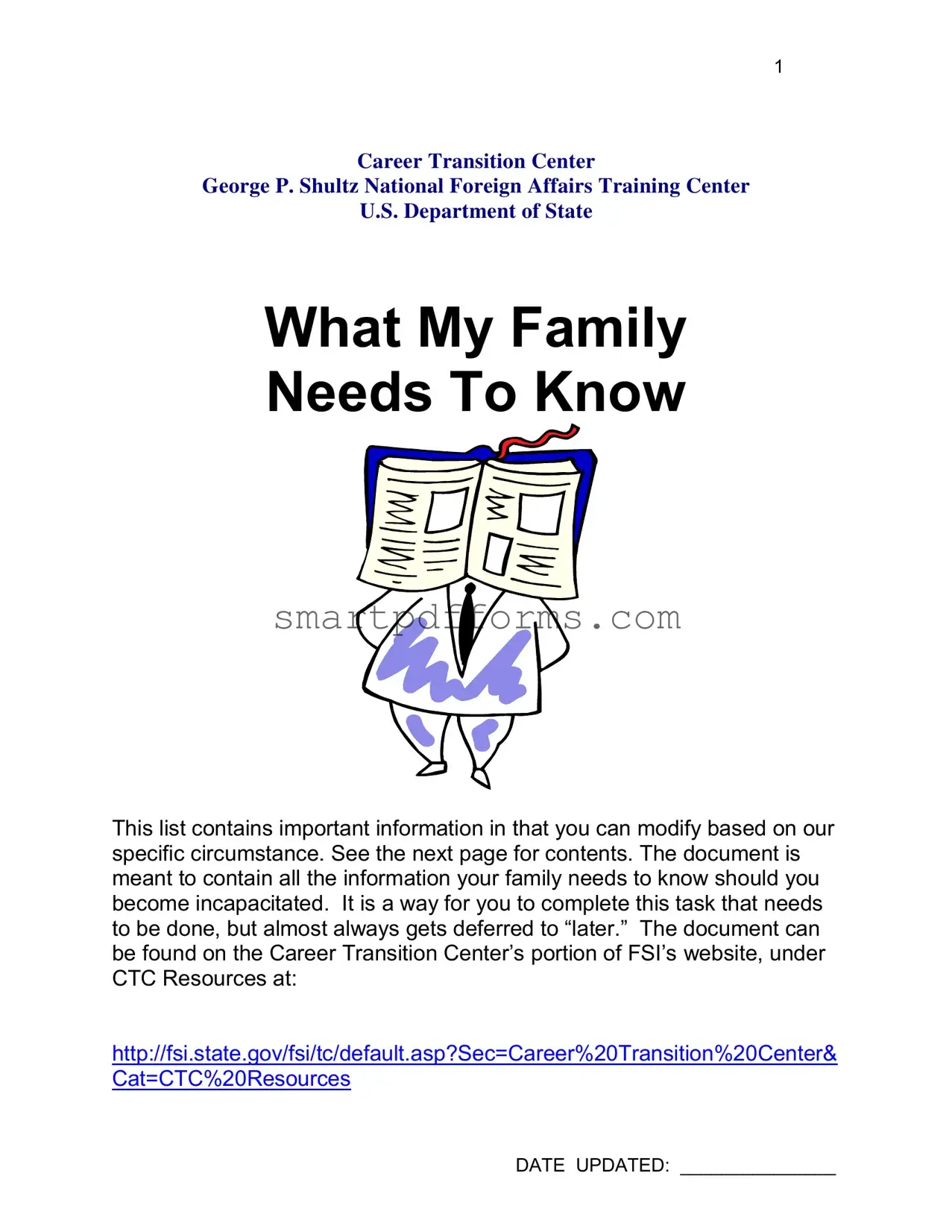1
Career Transition Center
George P. Shultz National Foreign Affairs Training Center
U.S. Department of State
What My Family
Needs To Know
This list contains important information in that you can modify based on our specific circumstance. See the next page for contents. The document is meant to contain all the information your family needs to know should you
become incapacitated. It is a way for you to complete this task that needs to be done, but almost always gets deferred to “later.” The document can be found on the Career Transition Center’s portion of FSI’s website, under
CTC Resources at:
http://fsi.state.gov/fsi/tc/default.asp?Sec=Career%20Transition%20Center&
Cat=CTC%20Resources
DATE UPDATED: _______________
2
CONTENTS
QUICK GUIDE TO LOCATIONS ………………………………………………………3
PERSONAL & FAMILY
MY PERSONAL INFORMATION……………………………………………………………...4
MY MARITAL HISTORY………………………………………………………………………..6
MY SPOUSE ……………………………………………………………………………………8
MY FAMILY HISTORY ……………………………………………………………………….13
MY MEDICAL INFORMATION ………………………………………………………………16
EMERGENCY NOTIFICATION ……………………………………………………………..19
BUSINESS & LEGAL
MY LEGAL DOCUMENTS …………………………………………………………………...20
MY INSURANCE POLICIES………………………………………………………………….24
MY EMPLOYMENT …………………………………………………………………………..27
MY FINANCIAL INFORMATION …………………………………………………………….30
MY REAL ESTATE ……………………………………………………………………………34
MY UTILITIES …………………………………………………………………………………35
MY VEHICLES ………………………………………………………………………………...37
MISCELLANEOUS INFORMATION
MY PETS ………………………………………………………………………………………38
MY MEMBERSHIPS & CHARITIES ………………………………………………………...39
FINAL WISHES
FUNERAL ARRANGEMENTS ………………………………………………………………40
NOTIFICATION IN CASE OF DEATH ……………………………………………………...43
BIBLIOGRAPHY & RESOURCES……………………………………………………46
DATE UPDATED: _______________
3
QUICK GUIDE TO LOCATION OF MY IMPORTANT DOCUMENTS
(Copy and paste more, if necessary.)
DOCUMENT / ITEM |
LOCATION |
Address book – personal |
|
Address book – professional |
|
Adoption or legal guardianship papers |
|
Bank account information – check books, statements, |
|
debit cards, ATM cards, etc. |
|
Birth Certificate |
|
Credit cards – cards, statements, etc. |
|
Debts owed to me |
|
Deed |
|
Disability records & insurance |
|
Disposition of remains – prepaid burial plots, donor |
|
arrangements, etc. |
|
Divorce papers |
|
Employment – earnings & leave statements, contracts, |
|
etc. |
|
Family tree & other information |
|
Household effects inventory |
|
Income tax records |
|
Information on my inheritances |
|
Insurance policy – health |
|
Insurance policy – life |
|
Insurance policy – long term care |
|
Insurance policy – professional |
|
Insurance policy – property (mortgage, homeowners, |
|
etc.) |
|
Insurance policy – vehicle |
|
Investment records – stocks, bonds, 401K, IRA, etc. |
|
Key – safety deposit box |
|
Keys – home |
|
Keys – other properties |
|
Keys – vehicles |
|
Keys or combination - P.O. Box |
|
Lease |
|
Marriage certificate |
|
Military service records |
|
Miscellaneous debts I owe |
|
Naturalization papers |
|
Passport |
|
Pet records – vaccination, medical, AKC registration,etc. |
|
Power of attorney |
|
Social Security card |
|
Vaccination records |
|
Vehicle records – loan, title, registration, etc. |
|
Will, living will, etc. |
|
DATE UPDATED: _______________
4
MY PERSONAL INFORMATION
FULL NAME:
MAIDEN NAME:
SOCIAL SECURITY NUMBER:
DATE OF BIRTH:
PLACE OF BIRTH (include name of hospital, city, county, state, country):
CURRENT HOME ADDRESS:
LOCATION OF HOUSE KEYS:
CURRENT MAILING ADDRESS:
LOCATION OF POST OFFICE BOX KEYS OR COMBINATION:
CURRENT STATE OF LEGAL RESIDENCE (state in which I vote):
DRIVER’S LICENSE STATE & NUMBER:
HOME TELEPHONE:
CELLULAR TELEPHONE:
HOME FAX NUMBER:
PERSONAL E-MAIL ADDRESS(ES):
PERSONAL WEBSITE ADDRESS:
MARITAL STATUS:
DATE UPDATED: _______________
5
TOTAL NUMBER OF BIOLOGICAL, ADOPTED, & STEPCHILDREN:
LOCATION OF MY PERSONAL ADDRESS BOOK:
LOCATION OF MY PROFESSIONAL ADDRESS BOOK:
LOCATION OF INFORMATION REGARDING FAMILY TREE & HISTORY:
DATE UPDATED: _______________
6
MY MARITAL HISTORY
MY CURRENT MARRIAGE
NAME OF SPOUSE:
DATE & PLACE OF MARRIAGE:
LOCATION OF MARRIAGE CERTIFICATE:
SPOUSE’S SOCIAL SECURITY NUMBER:
SPOUSE’S DATE OF BIRTH:
SPOUSE’S PLACE OF BIRTH:
SPOUSE’S HOME ADDRESS:
SPOUSE’S HOME TELEPHONE:
SPOUSE’S E-MAIL ADDRESS:
SPOUSE’S PERSONAL WEBSITE ADDRESS:
SPOUSE’S EMPLOYER:
ADDRESS OF SPOUSE’S EMPLOYER:
SPOUSE’S WORK TELEPHONE:
SPOUSE’S E-MAIL ADDRESS:
NAME & TELEPHONE OF SPOUSE’S SUPERVISOR:
DATE UPDATED: _______________
7
MY PREVIOUS MARRIAGES
(Copy and paste more, if necessary.)
NAME OF FORMER SPOUSE:
DATE & PLACE OF MARRIAGE:
DATE & PLACE OF DIVORCE:
LOCATION OF DIVORCE PAPERS:
FORMER SPOUSE’S CURRENT HOME ADDRESS:
FORMER SPOUSE’S CURRENT HOME TELEPHONE:
FORMER SPOUSE’S CURRENT WORK TELEPHONE:
FORMER SPOUSE’S CURRENT E-MAIL ADDRESS:
DATE UPDATED: _______________
8
MY SPOUSE
NAME OF SPOUSE:
DATE & PLACE OF MARRIAGE:
LOCATION OF MARRIAGE CERTIFICATE:
SPOUSE’S SOCIAL SECURITY NUMBER:
SPOUSE’S DATE OF BIRTH:
SPOUSE’S PLACE OF BIRTH:
SPOUSE’S HOME ADDRESS:
SPOUSE’S HOME TELEPHONE:
SPOUSE’S E-MAIL ADDRESS:
SPOUSE’S PERSONAL WEBSITE ADDRESS:
SPOUSE’S EMPLOYER:
SPOUSE’S WORK TELEPHONE:
SPOUSE’S WORK E-MAIL ADDRESS:
ADDRESS OF SPOUSE’S EMPLOYER:
NAME & TELEPHONE OF SPOUSE’S SUPERVISOR:
DATE UPDATED: _______________
9
SPOUSE’S MARITAL HISTORY
(Copy and paste more, if necessary.)
NAME OF FORMER SPOUSE:
DATE & PLACE OF PREVIOUS MARRIAGE:
DATE & PLACE OF DIVORCE:
HOME ADDRESS OF FORMER SPOUSE:
HOME TELEPHONE OF FORMER SPOUSE:
WORK TELEPHONE OF FORMER SPOUSE:
E-MAIL ADDRESS OF FORMER SPOUSE:
SPOUSE’S CHILDREN WITH ME
(Copy and paste more, if necessary.)
NAME:
DATE OF BIRTH:
PLACE OF BIRTH:
SOCIAL SECURITY NUMBER:
ADDRESS:
TELEPHONE:
E-MAIL:
SPOUSE’S CHILDREN BY PREVIOUS MARRIAGE (Copy and paste more, if necessary.)
NAME:
DATE OF BIRTH:
DATE UPDATED: _______________
10
PLACE OF BIRTH:
SOCIAL SECURITY NUMBER:
ADDRESS:
TELEPHONE:
E-MAIL:
SPOUSE’S PARENTS
FATHER’S NAME:
DATE OF BIRTH:
PLACE OF BIRTH:
DATE OF DEATH:
PLACE OF BURIAL:
CAUSE OF DEATH:
SOCIAL SECURITY NUMBER:
ADDRESS:
HOME TELEPHONE:
WORK TELEPHONE:
CELLULAR TELEPHONE:
E-MAIL:
MOTHER’S NAME:
MOTHER’S MAIDEN NAME:
DATE OF BIRTH:
DATE UPDATED: _______________


